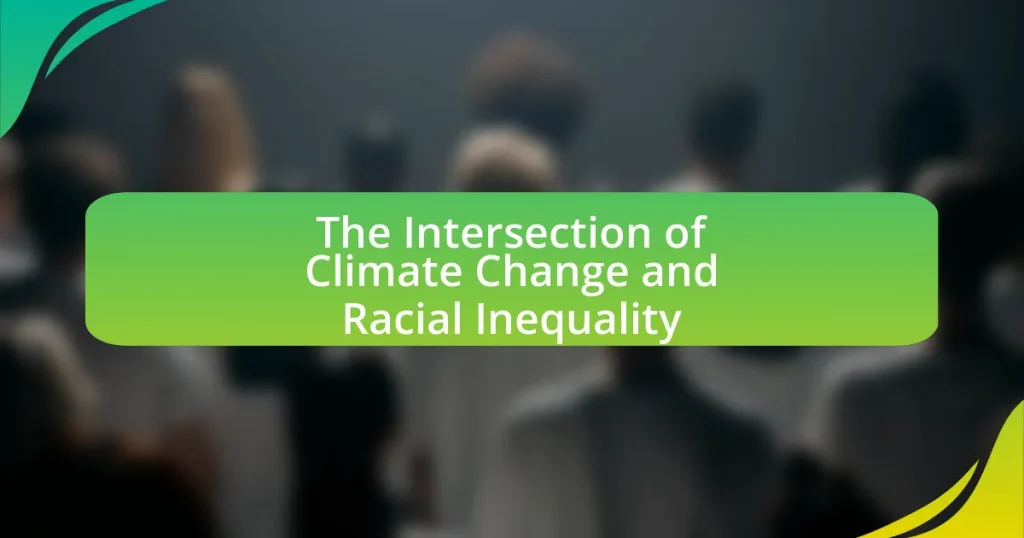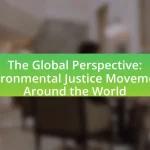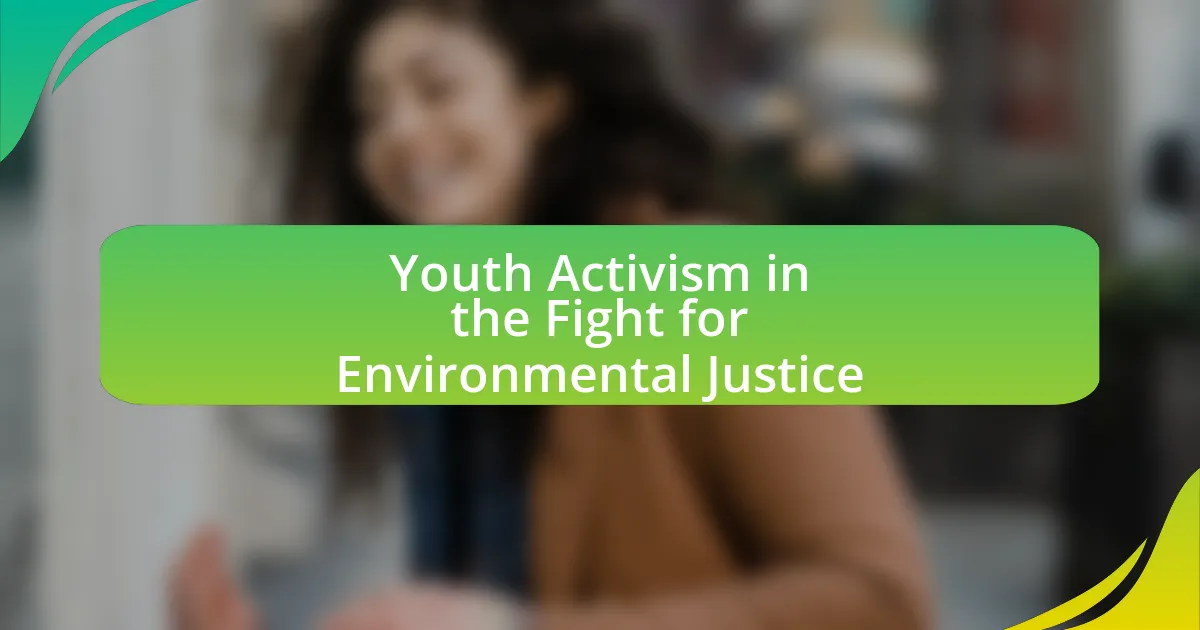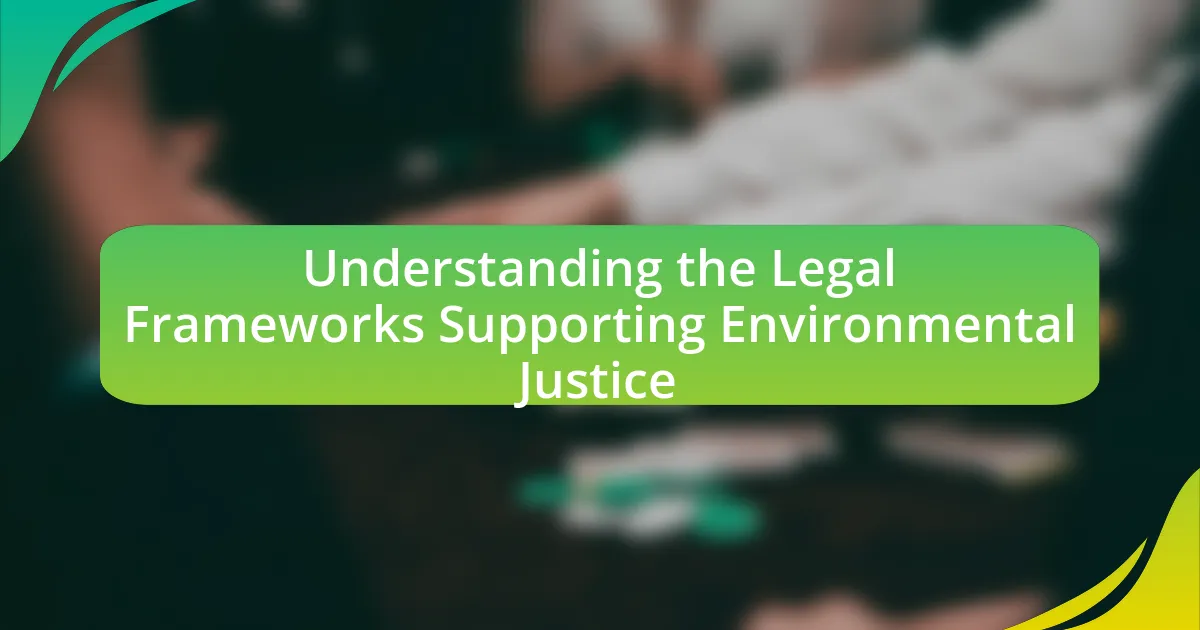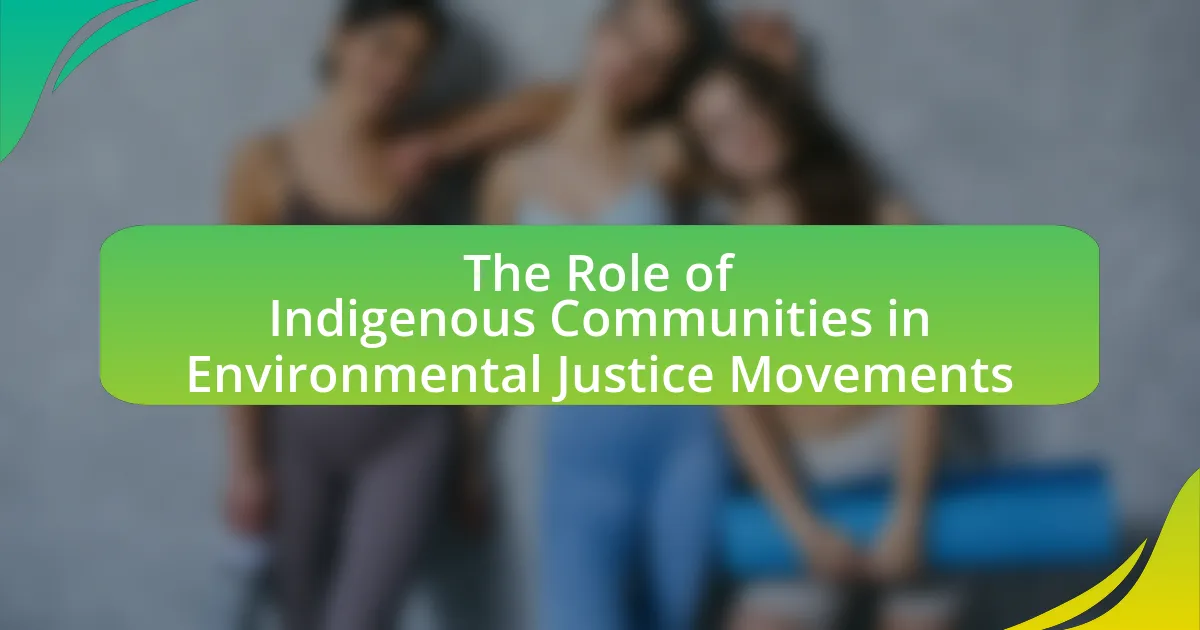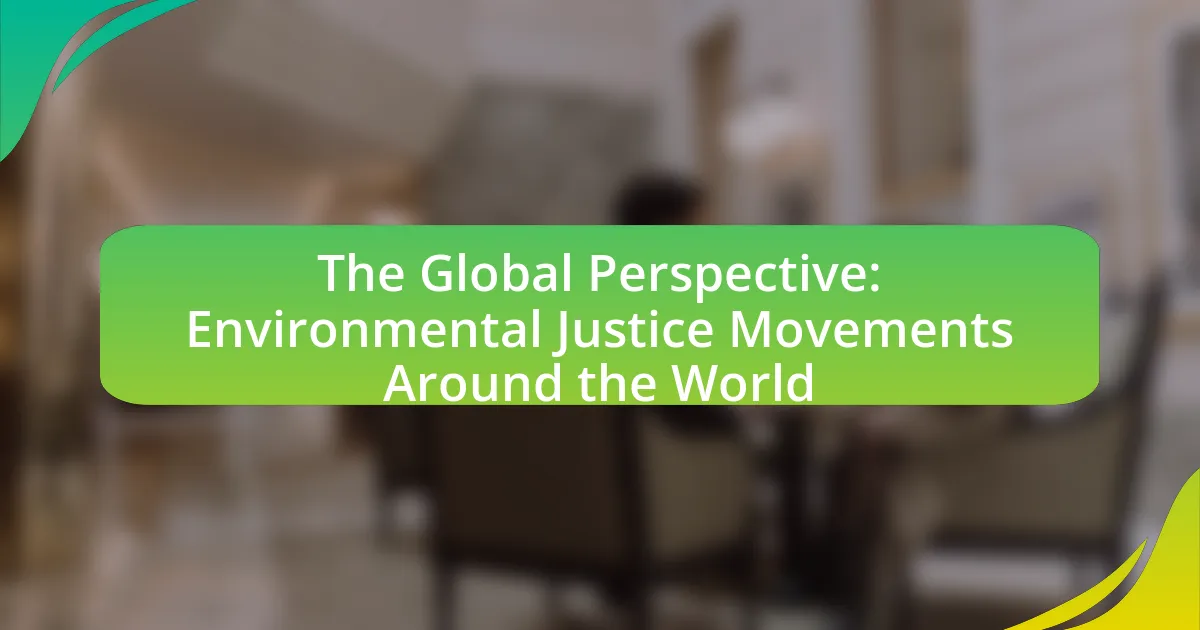The article examines the intersection of climate change and racial inequality, highlighting how marginalized racial and ethnic communities disproportionately experience the impacts of environmental degradation. It discusses the systemic barriers these communities face, such as limited access to resources and higher exposure to environmental hazards, which exacerbate their vulnerability to climate-related disasters. Historical factors, including colonialism and systemic racism, contribute to these disparities, necessitating integrated policies that address both climate change and social inequities. The article emphasizes the importance of inclusive policies, grassroots movements, and education in fostering resilience and promoting equitable climate solutions for affected communities.
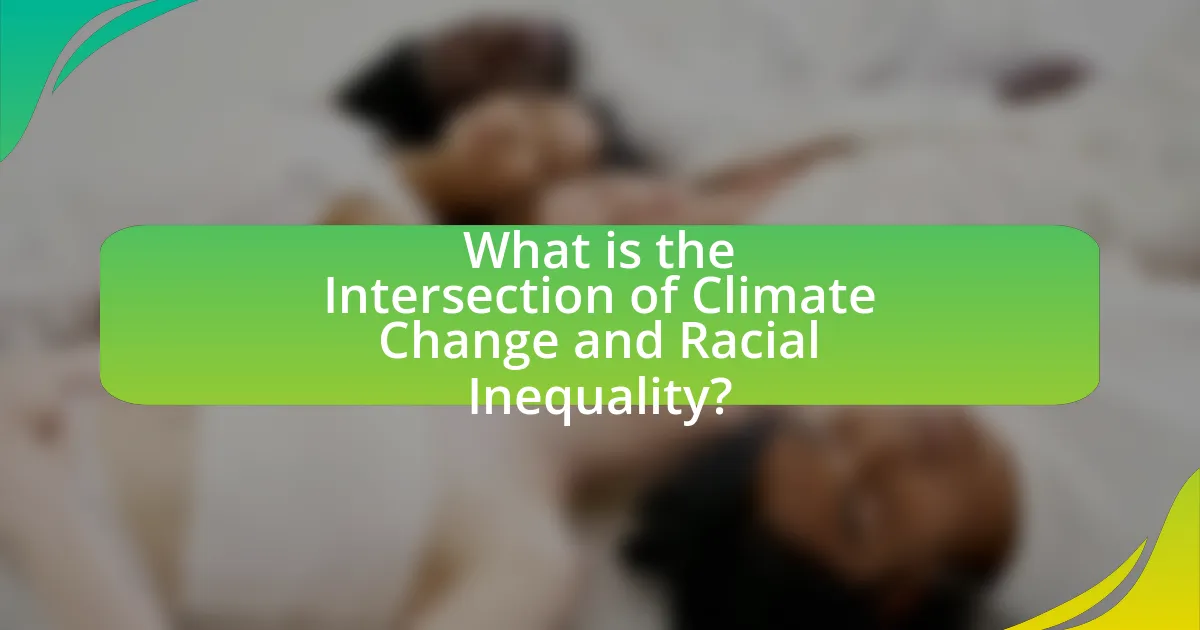
What is the Intersection of Climate Change and Racial Inequality?
The intersection of climate change and racial inequality refers to the disproportionate impact that climate change has on marginalized racial and ethnic communities. These communities often face greater exposure to environmental hazards, limited access to resources for adaptation, and systemic barriers that exacerbate their vulnerability. For instance, studies show that Black and Latino populations in the United States are more likely to live in areas with higher pollution levels and are less equipped to recover from climate-related disasters, such as hurricanes and floods. According to the National Climate Assessment, communities of color are at a higher risk of health issues related to climate change, highlighting the urgent need for equitable climate policies that address these disparities.
How do climate change and racial inequality relate to each other?
Climate change and racial inequality are interconnected, as marginalized communities often face the greatest impacts of environmental degradation while having the least resources to adapt. Research indicates that low-income and minority populations are disproportionately affected by climate-related disasters, such as hurricanes and heatwaves, due to factors like inadequate housing, limited access to healthcare, and systemic discrimination. For instance, a study by the National Oceanic and Atmospheric Administration (NOAA) found that Black and Hispanic communities in the United States are more likely to live in areas vulnerable to flooding and extreme heat, exacerbating existing health disparities. This relationship highlights how climate change not only poses environmental challenges but also reinforces social inequities, making it essential to address both issues simultaneously for effective solutions.
What historical factors contribute to the intersection of these issues?
Historical factors contributing to the intersection of climate change and racial inequality include colonialism, systemic racism, and economic disparity. Colonialism established exploitative practices that marginalized indigenous populations and communities of color, leading to unequal access to resources and decision-making power. Systemic racism has perpetuated environmental injustices, where minority communities often face higher exposure to pollution and climate-related disasters. Economic disparity further exacerbates these issues, as lower-income populations, predominantly composed of racial minorities, lack the financial means to adapt to climate impacts or recover from environmental crises. For instance, studies show that neighborhoods with higher percentages of people of color are more likely to be located near hazardous waste sites, illustrating the direct link between historical injustices and current environmental vulnerabilities.
How do systemic inequalities exacerbate the effects of climate change on marginalized communities?
Systemic inequalities exacerbate the effects of climate change on marginalized communities by limiting their access to resources, decision-making power, and adaptive capacity. These communities often reside in areas more vulnerable to climate impacts, such as flood-prone zones or urban heat islands, due to historical disinvestment and discriminatory policies. For instance, a report by the National Oceanic and Atmospheric Administration (NOAA) highlights that low-income neighborhoods face higher exposure to extreme heat, which can lead to health issues and increased mortality rates. Additionally, marginalized groups frequently lack the financial means to recover from climate-related disasters, as evidenced by the fact that Black and Hispanic households are more likely to experience economic hardship following such events, according to the Federal Reserve. This systemic disadvantage results in a cycle of vulnerability, where the impacts of climate change are felt more severely due to pre-existing social and economic inequalities.
Why is it important to address both climate change and racial inequality together?
Addressing both climate change and racial inequality together is crucial because marginalized communities disproportionately suffer from the impacts of climate change while contributing the least to its causes. Research indicates that low-income and minority populations face higher exposure to environmental hazards, such as air pollution and extreme weather events, which exacerbates existing social and economic disparities. For instance, a study by the National Academy of Sciences found that Black Americans are 40% more likely to live in areas with high pollution levels compared to white Americans. This intersectionality highlights the need for integrated policies that promote environmental justice and equitable climate solutions, ensuring that vulnerable populations are prioritized in climate action efforts.
What are the social implications of ignoring this intersection?
Ignoring the intersection of climate change and racial inequality leads to exacerbated social disparities and increased vulnerability among marginalized communities. When climate policies fail to consider racial inequalities, the most affected populations, often low-income and minority groups, face heightened risks from environmental hazards, such as extreme weather events and pollution. For instance, studies show that Black and Hispanic communities are disproportionately located in areas with higher exposure to climate-related risks, resulting in greater health issues and economic instability. Furthermore, neglecting this intersection perpetuates systemic inequities, as these communities are often excluded from decision-making processes regarding climate adaptation and resource allocation, thereby reinforcing cycles of poverty and disenfranchisement.
How can addressing both issues lead to more effective solutions?
Addressing both climate change and racial inequality can lead to more effective solutions by creating comprehensive strategies that consider the interconnectedness of environmental and social issues. When policies are designed to tackle climate change while simultaneously addressing racial disparities, they can ensure that vulnerable communities receive the support needed to adapt to environmental changes. For instance, research from the National Academy of Sciences indicates that marginalized groups often face greater risks from climate impacts, such as extreme weather events, due to systemic inequalities. By integrating social equity into climate action plans, resources can be allocated more effectively, fostering resilience and promoting sustainable development that benefits all demographics. This dual approach not only enhances the effectiveness of solutions but also promotes social justice, leading to a more equitable society.
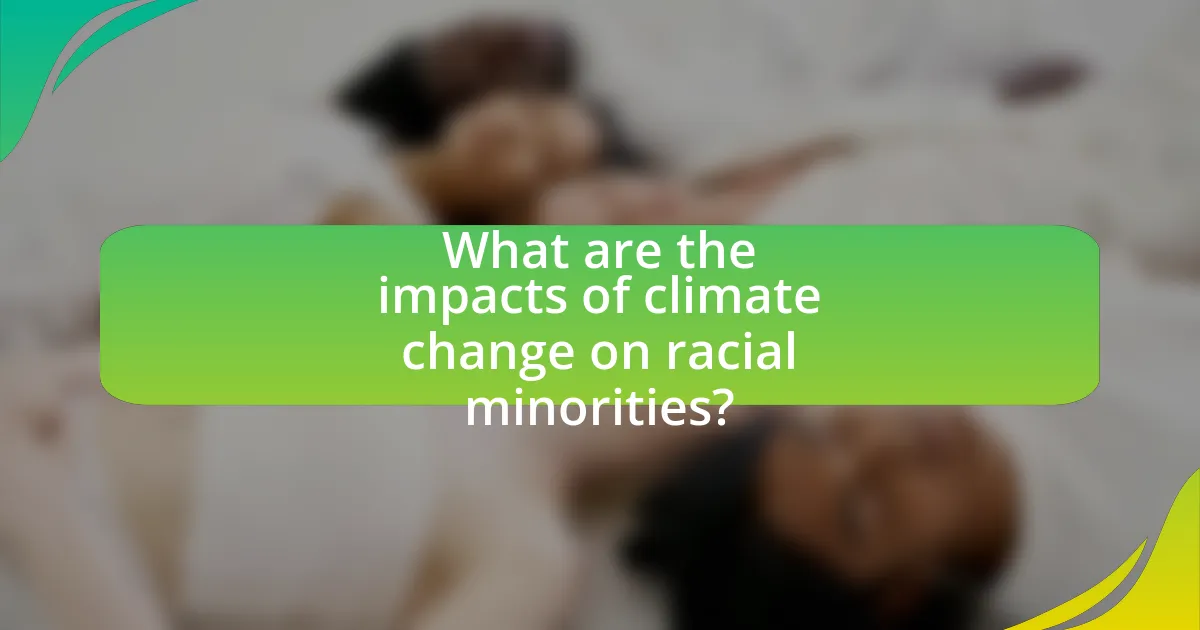
What are the impacts of climate change on racial minorities?
Climate change disproportionately impacts racial minorities through increased exposure to environmental hazards, health risks, and socioeconomic vulnerabilities. For instance, communities of color often reside in areas more susceptible to flooding, heatwaves, and air pollution, which exacerbates existing health disparities. According to the National Climate Assessment, Black and Hispanic populations are more likely to live in regions with higher temperatures and poorer air quality, leading to increased rates of respiratory illnesses and heat-related deaths. Furthermore, racial minorities frequently face barriers to accessing resources for climate adaptation, such as financial assistance and emergency services, which heightens their vulnerability during climate-related disasters.
How does climate change disproportionately affect communities of color?
Climate change disproportionately affects communities of color due to systemic inequalities that exacerbate their vulnerability to environmental hazards. These communities often reside in areas with higher exposure to pollution and climate-related disasters, such as floods and heatwaves, due to historical redlining and discriminatory zoning practices. For instance, a report by the NAACP and the Clean Air Task Force highlights that African American communities are more likely to live near industrial sites, leading to increased health risks from air pollution. Additionally, limited access to resources, such as financial support for recovery and infrastructure improvements, further hinders their ability to adapt to climate impacts. This systemic disadvantage results in higher rates of displacement and economic instability in communities of color during climate-related events.
What specific environmental hazards are these communities facing?
Communities facing the intersection of climate change and racial inequality are specifically dealing with hazards such as increased flooding, extreme heat, and air pollution. These environmental hazards disproportionately affect marginalized groups due to their geographic locations, often in flood-prone areas or urban heat islands. For instance, a study by the National Oceanic and Atmospheric Administration (NOAA) indicates that low-income neighborhoods are more likely to experience severe flooding due to inadequate infrastructure. Additionally, the American Lung Association reports that communities of color are more exposed to air pollution, which exacerbates health issues like asthma and respiratory diseases.
How do economic factors influence vulnerability to climate change?
Economic factors significantly influence vulnerability to climate change by determining the resources available for adaptation and resilience. Communities with lower income levels often lack the financial means to invest in infrastructure, technology, and services that mitigate climate impacts, such as flood defenses or sustainable agricultural practices. For instance, a study by the National Oceanic and Atmospheric Administration (NOAA) found that low-income neighborhoods are more likely to experience severe consequences from climate events due to inadequate housing and limited access to emergency services. Additionally, economic disparities can lead to unequal access to information and resources, further exacerbating vulnerability among marginalized groups.
What role does policy play in addressing these intersecting issues?
Policy plays a critical role in addressing the intersecting issues of climate change and racial inequality by establishing frameworks that promote equitable resource distribution and environmental justice. Effective policies can mitigate the disproportionate impacts of climate change on marginalized communities, ensuring that these groups receive adequate support and resources for adaptation and resilience. For instance, the Green New Deal proposed in the United States aims to create jobs in renewable energy sectors while prioritizing investments in communities of color that are often most affected by environmental degradation. This approach is supported by research from the National Academy of Sciences, which highlights that targeted policy interventions can significantly reduce vulnerability and enhance adaptive capacity among disadvantaged populations.
How can inclusive policies mitigate the impacts of climate change on racial minorities?
Inclusive policies can mitigate the impacts of climate change on racial minorities by ensuring equitable access to resources, decision-making processes, and climate adaptation strategies. These policies can address systemic inequalities that disproportionately affect racial minorities, such as limited access to clean air, safe housing, and healthcare. For instance, research from the National Oceanic and Atmospheric Administration indicates that communities of color are more likely to be located in areas vulnerable to climate-related disasters. By implementing inclusive policies that prioritize these communities, governments can allocate funding for infrastructure improvements, enhance disaster preparedness, and promote community engagement in climate resilience planning. This approach not only empowers racial minorities but also fosters a more equitable response to climate change, ultimately reducing their vulnerability and enhancing their adaptive capacity.
What examples exist of successful policy interventions?
Successful policy interventions addressing the intersection of climate change and racial inequality include the Green New Deal in the United States and the Climate Justice Movement. The Green New Deal aims to create jobs in renewable energy sectors while prioritizing marginalized communities, thereby addressing both economic and environmental injustices. The Climate Justice Movement advocates for policies that ensure equitable distribution of resources and protections for vulnerable populations affected by climate change. These interventions have been supported by various studies, including research from the Institute for Policy Studies, which highlights the positive impacts of green jobs on low-income communities and communities of color.
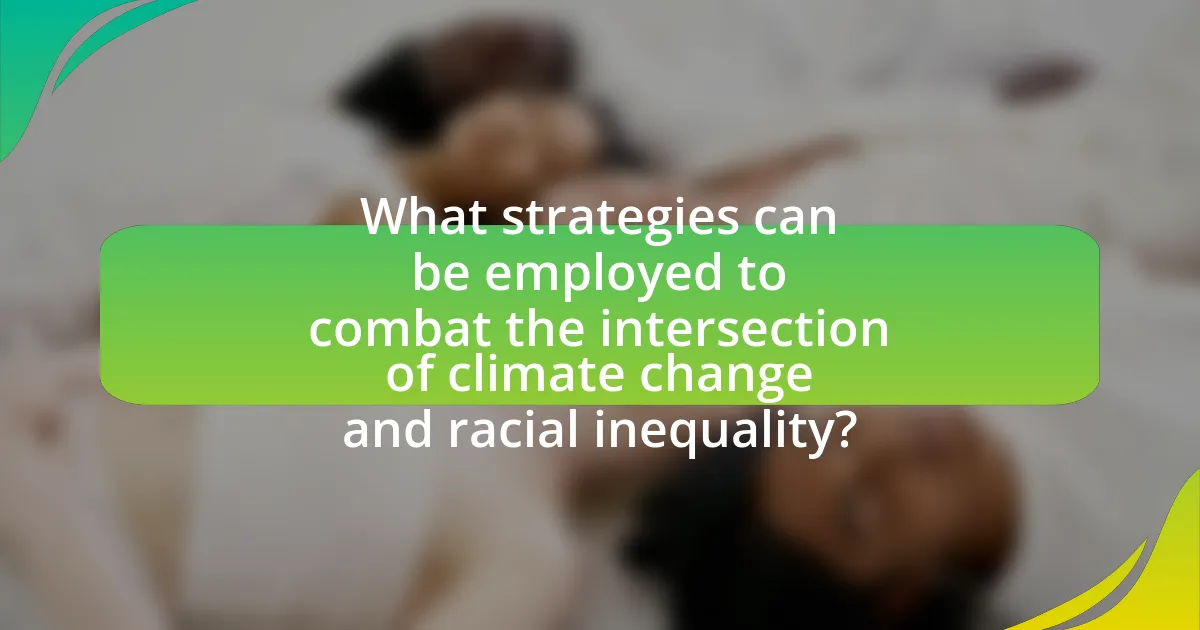
What strategies can be employed to combat the intersection of climate change and racial inequality?
Strategies to combat the intersection of climate change and racial inequality include implementing equitable climate policies, investing in renewable energy in marginalized communities, and enhancing community resilience through education and resources. Equitable climate policies ensure that vulnerable populations receive support and protection from climate impacts, as evidenced by the Green New Deal, which aims to address both environmental and social justice. Investing in renewable energy projects in low-income neighborhoods not only reduces carbon emissions but also creates jobs, as seen in initiatives like the Solar for All program in Washington, D.C., which aims to provide solar energy access to underserved communities. Additionally, enhancing community resilience through education and resources empowers individuals to adapt to climate changes, supported by programs like the Urban Heat Island Effect initiative, which educates communities on mitigating heat impacts.
How can grassroots movements contribute to solutions?
Grassroots movements can contribute to solutions by mobilizing communities to advocate for policy changes that address both climate change and racial inequality. These movements often highlight the disproportionate impact of environmental issues on marginalized communities, thereby raising awareness and driving collective action. For instance, the Black Lives Matter movement has intersected with environmental justice, emphasizing how climate change exacerbates existing racial disparities. Research shows that communities engaged in grassroots activism are more likely to influence local policies, as seen in the success of initiatives like the Green New Deal, which aims to create equitable climate solutions.
What are some successful case studies of community-led initiatives?
Successful case studies of community-led initiatives include the Greenbelt Movement in Kenya, which empowered local women to plant trees and restore degraded land, resulting in over 51 million trees planted and improved community resilience to climate change. Another example is the Detroit Black Community Food Security Network, which promotes urban agriculture and food sovereignty, addressing food deserts and enhancing local food systems. Additionally, the South Bronx Environmental Justice Coalition has successfully advocated for cleaner air and environmental justice, leading to policy changes that benefit marginalized communities. These initiatives demonstrate the effectiveness of grassroots efforts in tackling climate change and racial inequality.
How can these movements influence larger policy changes?
Movements addressing climate change and racial inequality can influence larger policy changes by mobilizing public support and raising awareness about interconnected issues. For instance, grassroots organizations often highlight how marginalized communities disproportionately suffer from environmental degradation, leading to increased advocacy for equitable policies. Research shows that movements like Black Lives Matter and climate justice campaigns have successfully pressured governments to adopt policies that prioritize environmental justice, such as the Green New Deal in the United States, which aims to address both climate change and economic inequality. These movements leverage social media and public demonstrations to amplify their messages, creating a sense of urgency that compels policymakers to act.
What role does education play in addressing these issues?
Education plays a crucial role in addressing the intersection of climate change and racial inequality by equipping individuals with the knowledge and skills necessary to understand and tackle these complex issues. Through education, communities can raise awareness about the disproportionate impacts of climate change on marginalized groups, fostering advocacy for equitable policies. For instance, studies show that educational programs focused on environmental justice can empower underrepresented populations to engage in climate action, thereby reducing vulnerability and promoting resilience. Furthermore, research from the National Academy of Sciences indicates that education can enhance critical thinking and problem-solving abilities, enabling individuals to develop innovative solutions to mitigate climate-related challenges faced by racially diverse communities.
How can awareness and education empower affected communities?
Awareness and education empower affected communities by providing them with the knowledge and skills necessary to advocate for their rights and address the impacts of climate change. For instance, educational programs that focus on climate science and its socio-economic effects enable community members to understand the specific challenges they face, such as increased flooding or heatwaves, which disproportionately affect marginalized groups. Research from the National Academies of Sciences indicates that informed communities are more likely to engage in local decision-making processes, leading to better resource allocation and policy changes that reflect their needs. Furthermore, awareness campaigns can mobilize community action, fostering solidarity and collective efforts to demand environmental justice, as seen in movements like the Sunrise Movement, which emphasizes the intersection of climate action and social equity.
What resources are available for educating communities about climate change and racial inequality?
Resources available for educating communities about climate change and racial inequality include organizations, educational programs, and online platforms. For instance, the NAACP provides resources and reports that highlight the impact of climate change on marginalized communities, emphasizing the need for equitable solutions. The Climate Reality Project offers training programs that focus on the intersection of climate issues and social justice, equipping community leaders with the knowledge to advocate for change. Additionally, online platforms like Coursera and edX host courses on climate justice, which address both environmental and racial disparities. These resources collectively aim to raise awareness and foster understanding of how climate change disproportionately affects racial and ethnic minorities.
What practical steps can individuals take to support this intersection?
Individuals can support the intersection of climate change and racial inequality by advocating for policies that address both issues simultaneously. Engaging in community organizing to promote equitable climate solutions, such as renewable energy access for marginalized communities, is essential. Research indicates that low-income and minority communities are disproportionately affected by climate change, highlighting the need for targeted interventions. Supporting organizations that focus on environmental justice, such as the NAACP’s Environmental and Climate Justice Program, can amplify efforts to address these disparities. Additionally, individuals can educate themselves and others about the impacts of climate change on racial inequality, fostering a more informed public discourse that prioritizes equity in climate action.
